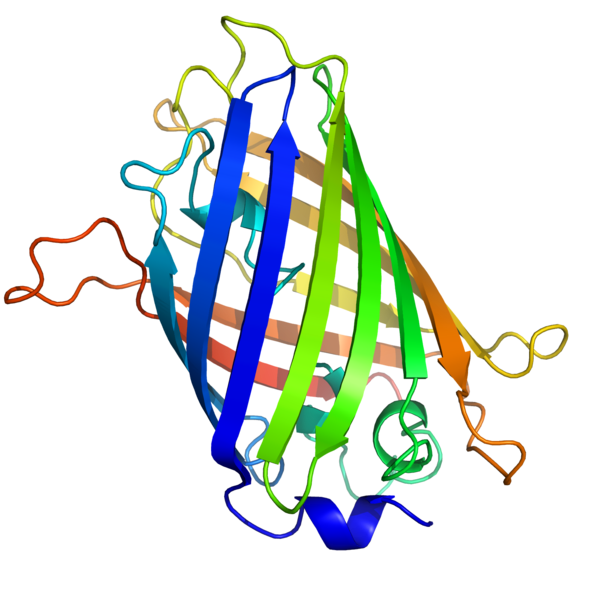- français
- English
Fluorescence
When we had to choose a direction, between Arsenic and Coliform bacteria detection, we were interested by fluorescence. Indeed, to detect Arsenic, we can use a bacteria engineered in Van der Meer's lab that express fluorescence in response to Arsenic. And we discovered that E.Coli can also be detected using fluorescence (E.Coli detection is used to infer Coliform bacteria presence).
To understand how we worked, we need to know:
- What is fluorescence?
- How is fluorescence related to a bacteria?
- What is GFP and how does it work?
- How do we measure fluorescence?
What is fluorescence?
Something that is fluorescent means that it emits light with a certain wavelength caused by the absorption of light having another specific wavelength. Usually, the exciting wavelength is smaller than the emitted wavelength, hence, the excitation has a higher energy than the emission. The fluorescence can also be caused by another electromagnetic radiation than light.
The basic physical fact is that a photon from the exciting light is absorbed by the fluorescing thing, this absorption causes one electron to change its quantum state because the photon gives the electron the necessary energy to go to a higher state. This electron returns to its ground state after a while, and emits the remaining energy under the form of another photon, which has a different wavelenght than the exciting photon. this produce light that is called fluorescence. The excitation of an electron that relaxes a photon while going back to its ground state is also possible with other types of excitation than light, such as heat or chemical reactions. But in this case, we speak of luminescence.
How is fluorescence related to a bacteria?
Many minerals or organic coumpounds fluoresce with UV light. Is it the case of aromatic amino-acids and nucleic acids we find in a bacteria. They act as natural fluorophores, and we can use fluorescence with UV excitation to measure the quantity of such fluorophores in a sample. Knowing the fluorescent emission spectrum of a bacteria, we can infer the quantity of it in a sample.
In the bacteria developped to act as an Arsenic biosensor that we want to use, Arsenic presence is detected by the bacteria and its presence activates a gene that was introduced in the bacteria: the green fluorescent protein. This protein, once expressed, act as a fluorophore and we can measure its activity. Hence, we measure GFP fluorescence and not directly E.Coli fluorescence.
What is GFP and how does it work?
 The green fluorescent protein, is a protein native to the jellyfish Aequorea Victoria. It is a 27kDa protein mostly formed with beta-sheet making a sort of tube. It acts as a fluorophore. The wild type absorbs light at 395nm and emits light at 509nm, fluorescing with a green light. It was first isolated in the 1960s, but in 1992, its gene was analyzed and published in Gene.
The green fluorescent protein, is a protein native to the jellyfish Aequorea Victoria. It is a 27kDa protein mostly formed with beta-sheet making a sort of tube. It acts as a fluorophore. The wild type absorbs light at 395nm and emits light at 509nm, fluorescing with a green light. It was first isolated in the 1960s, but in 1992, its gene was analyzed and published in Gene.
From this discovery, Gfp has been used for molecular biology studies: it can be attached to another protein and measured to understand where this protein is present and/or active and many other applications. Among these, the gene of GFP is positionned after the promoter activated in our bacteria when it senses Arsenic, allowing its expression when Arsenic is present.
Other developpments have been made to GFP, creating other fluorescent proteins either excitted by another wavelenght or emitting at another wavelenght. Today, a whole rainbow of fluorescent proteins exists. These developpments with GFP were rewarded by a Nobel Prize in 2008.
How do we measure fluorescence?
To quantify the emitted fluorescence of a substance, we have to use a dispositive to measure the quantity of light at emission wavelength. Some fluorometer exist that illuminate a sample with a precise wavelength and collect the emitted light at another specific wavelenght. Other techniques exist that are measuring a fluorescent spectrum either by illluminating the sample with different wavelengths, or by collecting the emitted light at different wavelengths. The problem of the collection, is that we need to collect light being sure that we do not collect the exciting light, which would distort the results.
In our case, we tried to ways of thinking: either collecting all the light and applying analytic filters afterward in order to measure only the light at the wavelenght we are interested in; or applying optic filters before the light collection to be sure the exciting light is not touching the photoreceptor used for collection.
- Ce wiki
- Cette page
